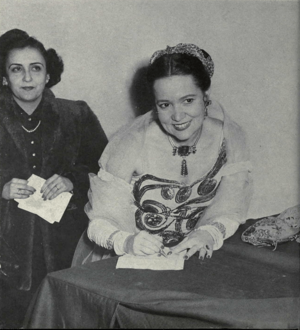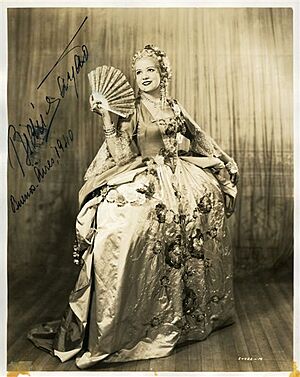Bidu Sayão facts for kids
Quick facts for kids
Bidu Sayão
|
|
|---|---|

Sayão during a visit to the University of Michigan (c. 1953)
|
|
| Born |
Balduína de Oliveira Sayão
11 May 1902 Itaguaí, Rio de Janeiro
|
| Died | 12 March 1999 (aged 96) |
| Occupation | Opera soprano |
| Years active | 1920–1952 |

Balduína "Bidú" de Oliveira Sayão (born May 11, 1902 – died March 12, 1999) was a famous Brazilian opera singer. She was known as a soprano, which is a high female singing voice. Bidu Sayão was one of Brazil's most celebrated musicians. She was a main performer at the Metropolitan Opera in New York City from 1937 to 1952.
Contents
Bidu Sayão's Life and Career
Bidu Sayão was born on May 11, 1902, in Itaguaí, Rio de Janeiro, Brazil. Her family had roots in Portugal, France, and Switzerland. Her father passed away when she was only five years old. Her mother worked hard to help Bidu follow her dream of becoming a singer.
When Bidu was 18, she made her first big opera performance in Rio de Janeiro. This performance led to an amazing chance to study with Elena Teodorini. She first studied in Brazil, then in Romania. Later, she studied with the famous Polish singer Jean de Reszke in Nice, France.
In the 1920s and early 1930s, Bidu Sayão performed in many big cities. She sang in Rome, Buenos Aires, and Paris. She also performed in her home country of Brazil. While singing at the Teatro Costanzi in Rome, she met Walter Mocchi. They later got married. In 1935, Sayão married another singer, Italian baritone Giuseppe Danise.
In 1930, she performed at the Teatro alla Scala in Milan, Italy. The next year, she sang as Juliette in Gounod's Roméo et Juliette at the Paris Opera. In the same year, she became very successful with her first performance as Lakmé at the Opéra Comique. She quickly became one of Europe's top lyric coloratura sopranos. This type of singer has a light, flexible, and high voice. She was especially popular in Italy and France. Her roles included characters from famous operas like Lucia di Lammermoor and La sonnambula.
Performing at the Metropolitan Opera
Bidu Sayão first performed in the United States on December 30, 1935. This was a concert at Town Hall in New York City. Her first U.S. opera performance was on January 21, 1936. She sang in Lakmé by Léo Delibes. A few months later, she sang with the New York Philharmonic orchestra at Carnegie Hall. She performed La Damoiselle élue by Claude Debussy. This performance was led by Arturo Toscanini, a very famous conductor. He became a great supporter and friend to Bidu Sayão.
She sang for the first time at the Metropolitan Opera on February 13, 1937. She performed the role of Manon. Critics loved her performance. Olin Downes from The New York Times praised her greatly. Soon after, she was given the main role in La traviata. Then she sang as Mimì in La bohème. She also helped bring back the music of Wolfgang Amadeus Mozart at the Metropolitan Opera. She became the best Zerlina in (Don Giovanni) and Susanna in (The Marriage of Figaro) of her time.
In 1948, she performed at the University of Michigan May Festival. She sang "Un Bel Di" from Madame Butterfly as an extra song.
Brazilian composer Heitor Villa-Lobos worked with Bidu Sayão for many years. She recorded many of his songs. One famous recording is of his Bachianas Brasileiras No. 5.
Bidu Sayão and her husband, Giuseppe Danise, bought a home in Lincolnville, Maine. After 15 years at the Metropolitan Opera, she gave her last performance there in 1952. For the next two years, she performed as a guest singer across the U.S. In 1957, she stopped performing in public completely. Two years later, she made her final recording. She was the main singer on Villa-Lobos's Forest of the Amazon. The composer himself conducted the orchestra.
After her husband passed away in 1963, Sayão lived quietly in her Maine home. She visited Brazil one last time in 1995. This was for a special tribute to her during the Carnival in Rio de Janeiro. Bidu Sayão died on March 12, 1999, at age 96. Her ashes were spread over the bay in front of her home.
Bidu Sayão's Legacy
After her last visit to Brazil, the government planned ways to honor her memory. In 2000, the Bidu Sayão International Vocal Competition was started. This competition helps new Brazilian opera singers show their talent to the world. A painting of Sayão by Curtis Ether hangs in the lobby of the Metropolitan Opera House in New York City.
See also
 In Spanish: Bidu Sayão para niños
In Spanish: Bidu Sayão para niños

